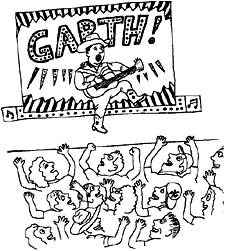Movies

Conspiracy Theory (Warner Bros.). Most critics chide the Richard Donner (Lethal Weapon) film as irredeemably far-fetched: A paranoid New York cabbie (Mel Gibson) and a lawyer (Julia Roberts) are chased by government assassins when one of the cabbie's fantastic theories turns out to be true. "[W]e don't believe a word of this," says Time's Richard Schickel. The New York Times' Janet Maslin is dubious about the casting: "The man who talks to himself and mails long, delusional screeds to strangers is not usually the dreamboat type." A few reviewers discern "tongue-in-cheek" humor in the use of sex symbol Gibson as a "poster boy for schizophrenia," and declare the film smarter than "other high-ticket summer fare" (Jack Mathews, Newsday). (Click here for the Conspiracy Theory site.)
Love Serenade (Miramax). A warm reception for rookie Australian director Shirley Barrett's "clever, deadpan comedy" (Maslin) about two sisters vying for the affection of a thrice-divorced radio DJ who moves to their outback town. "A wickedly funny examination of obsessive romantic behavior," says the Los Angeles Times' Kenneth Turan. Praise goes also to Barrett's gentle satire of the culturally backward outback (the radio station doesn't even have a CD player). Her idiosyncratic script and direction earn her comparisons to acclaimed antipodean auteurs Jane Campion and Gillian Armstrong. (Video clips and stills are available here.)
Television
VibeandThe Keenen Ivory Wayans Show (check local listings for channels and times). Critics scoff at two new late-night talk shows, hosted by black stand-up comics, as poor replicas of the early '90s hit TheArsenio Hall Show. Vibe, produced by Quincy Jones, and Keenen, made by the creator of the comedy series In Living Color, are pronounced "indistinguishable" (James Collins, Time) and "hard to stay awake through" (Howard Rosenberg, the Los Angles Times). The main gripes are that the programs stick to a "banal" (Caryn James, the New York Times) talk show formula and have even less bite than David Letterman's or Jay Leno's network show.

Event/Television
Garth Brooks in Central Park/Garth Brooks Live (Aug. 8, New York City; broadcast live on HBO). Bemused critics scratch their heads at the huge turnout (estimated as high as 1.1 million) for the country music megastar's live-broadcast concert. "So what ends up being the cultural event of the summer in the culture capital of the nation?" asks the New York Times' Michele Mitchell. Some see the concert as evidence of marketing acumen and a self-aggrandizing streak in the '90s' best-selling musician. Brooks' "neatly calibrated spectacle" (Jon Pareles, also in the New York Times), which included lots of smoke, lights, and cameos (by Billy Joel and Don McLean), was, Time says, "originally conceived as a mega-infomercial for his new CD." (HBO plugs its broadcast.)
Art
"Sculpture of Angkor and Ancient Cambodia: Millennium of Glory" (National Gallery of Art, Washington, D.C.). The first American show of classical Cambodian art in 50 years is said to "carry the force of a revelation" (Holland Cutter, the New York Times). Time's Robert Hughes calls the pieces, which mostly depict Buddha and other deities and date to the 6th century, "some of the greatest stone carving and bronze work in human history." Critics expect extra attention for the show because of the recent political turmoil in Cambodia. An editorial in the New Republic urges holding on to the art until democracy is restored in Cambodia. (See the National Gallery site. For a backgrounder on the Cambodian conflict, see Slate's "Gist.")
Books
Simenon: A Biography, by Pierre Assouline, translated by Jon Rothschild (Knopf). The biography of the legendary Belgian-French king of pulp fiction (1903-1989), who wrote more than 400 novels and bedded even more women (he estimated 10,000), is deemed masterful, "absorbing," and "definitive" (Deirdre Bair, the New York Times Book Review). Simenon wins praise for its defense of Simenon's oeuvre, often dismissed as hackery, and for its candid treatment of his misogyny and anti-Semitism. "Unlike altogether too many biographers, [Assouline] is capable of distinguishing between the singer and the song," says New York's Luc Sante.
Dispatches From the Freud Wars: Psychoanalysis and Its Passions, by John Forrester (Harvard University Press). A Cambridge don's assessment of recent indictments of psychoanalysis--including its alleged sexism, pseudoscience, and ineffectiveness--is deemed "dispassionate" (Sarah Boxer, the New York Times Book Review) by some, wishy-washy by others. Freudians claim Forrester brings the thinker's hyperbolic critics down to earth, while anti-Freudians say he pulls his punches. The book "strands the reader in the musty groves of academe and mutes the passions of the subtitle," says Jungian analyst Claire Douglas in the Washington Post Book World. (Harvard University Press plugs the book.)
Updates
The New Republic's Charles Lane says that News of a Kidnapping merely extends Gabriel García Márquez's record of "dishonest" journalism. "[T]he magical realist journalist is himself close to the people and the events that he is writing about, but does not feel the need to disclose this fully to his readers." ...New York's David Denby adds to the ruckus over In the Company of Men: It "is a repellent experience--a schematic, coldly cynical work that pretends to expose coldness and cynicism." ... In the Wall Street Journal, Roger Kimball attacks the recently deceased William S. Burroughs and Allen Ginsberg for their "pretentious, proselytizing pornography ... the Beats really do mark an important moment in American culture, not as one of its achievements, but as a grievous example of its degeneration."
Recent "Summary Judgment" columns
Movie--Career Girls;
Movie--In the Company of Men;
Movie--Spawn;
Book--Our Guys: The Glen Ridge Rape and the Secret Life of the Perfect Suburb, by Bernard Lefkowitz;
Book--Faith or Fear: How Jews Can Survive in a Christian America, by Elliott Abrams;
Death--William S. Burroughs;
Opera--Palestrina.
Movie--Air Force One;
Movie--Mrs. Brown;
Movie--Star Maps;
Architecture--National Airport;
Book--Martha Stewart, Just Desserts: The Unauthorized Biography, by Jerry Oppenheimer;
Book--A Book of Memories, by Peter Nadas, translated by Ivan Sanders with Imre Goldstein.
Movie--Contact;
Movie--Shall We Dance?;
Book--Lawyerland: What Lawyers Talk About When They Talk About the Law, by Lawrence Joseph;
Book--Straight Man, by Richard Russo;
Television--Roar (Fox);
Theater--Amy's View.
Movie--Men in Black;
Book--Women With Men, by Richard Ford;
Book--American Scripture: Making the Declaration of Independence, by Pauline Maier;
Book--Man Without a Face: The Autobiography of Communism's Greatest Spymaster, by Markus Wolf with Anne McElvoy;
Art--"Keith Haring" (Whitney Museum of American Art);
Television--Oz (HBO);
Music--Lilith Fair.
--Compiled by Franklin Foer and the editors of Slate.
